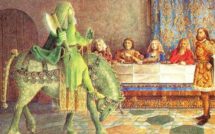

In France, the question of animal slaughter has been largely publicized by the animalist association L214. Throughout the past ten years, they have frequently published hidden camera images of slaughtering on their website. These videos constitute an effective gateway for debating about how people relate to livestock slaughter in contemporary France. First of all, they highlight the existence of the animal rights movement, which has become particularly active and public. We can generally distinguish two major channels for mobilization towards animal protection: the first—qualified as “reformist”—is driven by organizations that fight to improve living conditions for animals and their relationships with humans; the second—referred to as “abolitionist”—emanates from organizations that seek to abolish any form of animal use by humans, which they systematically see as unjustifiable domination and exploitation. While these two trends and the links between them remain complex (see for example Traïni 2011, Celka 2012, Carrié 2015), the focus on the abolitionist movement is particularly pertinent as it has been behind recent videos that prompted the creation of an inquiry committee on slaughtering conditions in French abattoirs. The committee was set up in 2016 by the French National Assembly (Falorni 2016) as a result of two videos calling into question practices in abattoirs located in Alès and Vigan. Since then, L214 has generated many more abattoir videos (four in 2016, two in 2017, two in 2018, three in 2020, and one in 2021), which are disseminated on a daily basis through traditional and social media.
In contrast with the channels for action adopted by abolitionist movements that fall under an “unveiling register” (Traïni 2011, 169), reformist organizations work generally to effect change in slaughtering practices through a medley of political lobbying, legal action, and professional training. Although different, both approaches interact, since abolitionist activism has placed reformist associations at the heart of various working groups that focus on the question of animal welfare in abattoirs. For example, the French National Interprofessional Livestock and Meat Association (Interbev) claimed to have “forged links in 2017 with four welfarist NGOs: L’Oeuvre d’Assistance aux Bêtes d’Abattoir (OABA – Assistance to Livestock in Abattoirs), Compassion In World Farming France (CIWF France), Welfarm – Protection mondiale des animaux de ferme (World protection for farm animals) and the Fondation Droit éthique et Science (LFDA – French animal rights league)” (Interbev, n.d.).
Making animal killing visible again
L214’s actions have had wide repercussions in France since the association introduced images of death in the public arena that people had never seen before. While the great strength of these actions is that they increase awareness by showing brutal scenes that had been made invisible to most people, it is not clear what images do generate indignation in viewers: is it the spectacle of suffering, seeing death itself, witnessing acts of cruelty, or facing the idea of having to kill for food? Although public butchery was common in medieval urban societies in Europe, overtime urban dwellers came to reject it based on interrelated political, hygienic, aesthetic, and moral reasons. As an example, the very first Parisian abattoirs were created in the early nineteenth century with, from the very onset, the will to distance butcher’s slaughter from the public sphere. Studying the work of the architects who designed and built these establishments, the historian Paula Young Lee reported that virtually all of the proposed projects comprised the same essential characteristic of a “modern” abattoir: it must be invisible, distant from urban areas, and separated from other social activities. This effort to keep slaughtering hidden was not limited to the creation of specialized establishments, but went as far as imposing architectural criteria to conceal any indication whatsoever on the nature of the activity within the building (Young Lee 2005). Moreover, urban populations, in particular the upper class, perceived slaughter houses as a “bloodthirsty and cruel spectacle, from which people, especially children, would be prudent to stay away or risk losing any sense of pity” (Abad 1998, 663).
Since the nineteenth century, societies have become increasingly more distanced from animal death. Today, hardly anyone witnesses the slaughter of an animal directly. This is why the reinsertion in the public space of raw images of killing have provoked a violent “moral shock” to citizens, in the sense that Christophe Traïni (2009) understands it: it follows an “unforeseen modification, more or less sudden, in people’s environment.” The unexpected introduction of slaughter videos in social spaces “causes a very lively, visceral reaction, sometimes felt physically even to the point of disgust, nausea, vertigo” (101-2) and leads people to ponder on the ways in which the order of the world deviates from their own values. These videos further arouse a feeling of horror and anger, and a need for an immediate reaction, prompting a commitment to action. This feeling of horror is reinforced by the fact that the animals are slaughtered in an industrial way, assembly-line slaughter giving the image of a coldly executed killing, without any compassion for the animals.
Discussing industrial slaughter
The very concept of “industrial slaughter” is challenging to define. It could be analyzed through the lens of Taylorism in the workplace, which replaced the small-scale butcher model in the second half of the twentieth century, or through the study of the effects of industrialization on working conditions. Nonetheless, approaching the term as if present-day slaughtering were exclusively the result of industrialization processes is reductive. Indeed, such essentialism brings us to consider contemporary slaughtering from the viewpoint of a profane, desymbolized, desacralized, amoral, or even immoral act, since it is orientated towards the techno-economic production of meat goods. Is it possible that contemporary slaughtering has become a simple technical social practice, devoid of any symbolic dimension, of any religious component, of any moral aspect? Can we truly consider, on the one hand, that purely technical acts may exist, and, on the other hand, that the slaughtering of living beings, all the more those humans have domesticated, could be solely of a technical order, in the sense, for example, set forth by Marcel Mauss (1936), as “experienced by the author [in this case the slaughterer] as a purely mechanical, physical or physico-chemical act,” and “pursued with this aim” (Mauss 1936, 10)? It would mean that the death of animals within the industrial complex is to be seen as merely about stopping their biological functions in the most efficient manner possible, independently “of any belief or any theory” (Sigaut 2012, 5). Looking back to history then, what role do moral motivations play in the ways in which slaughter has changed over time? In this context, it is worth exploring the recurrent controversy over Jewish and Muslim ritual slaughter practices and the issue of stunning. Stunning is a method that uses mechanical, gas, or electric devices to ensure that the animal is unconscious and therefore insensitive to pain before being bled out. Because some faith-based rituals are carried out through direct bleeding, i.e. without using any stunning system, they are strongly opposed by animal welfare associations that consider these acts as barbaric practices of another age and advocate for their outlawing, as the ecologist deputy Yannick Jadot has recently done (Maccaud 2021). Engaging with these questions helps to weaken the idea that contemporary slaughtering is solely a matter of technique and economics.
It is generally accepted that animal slaughtering became profane under the effect of secularization processes initiated by the Catholic Church and continued or even completed with the industrial era. A complete upheaval of standards in terms of animal slaughter occurred prior to the medieval period in the western world. Historians tell of a great number of ancient civilizations in which ritual and sacrificial practices were omnipresent. For example, as Marcel Detienne notes when speaking of Ancient Greece, “eating meat absolutely coincides with sacrificial practices; all consumed meat comes from an animal victim, whose throat has been ritually slit” (Detienne and Vernant 1979, 10). For some, Roman sources reveal that animal slaughtering was only considered in a religious setting (Scheid 1998, 15), while others report on a number of different sacrificial acts drawn from the Hebrew Bible (for example in Lemardelé 2014; Marx 2005; Lévy 2019). Things were to take a radical turn with the advent of Western Christianity, which levied Old Testament interdictions and prohibited sacrificial acts, although some of them persisted up to the tenth century (Bauer 2017; Laurioux 2014).
It is often considered that Western Christianity transformed animal slaughter into a purely profane activity. However, it would appear that a certain ambiguity remains: if the Church did abrogate interdictions pertaining to food and slaughtering rules, it did so religiously. The idea was not so much to render food or slaughter profane, but, on the contrary, to render them more religious according to the Christian conception that humans should not burden themselves with ritual prescriptions and food proscriptions, but that for good health they should eat anything without restraint, since salvation is sited elsewhere. The revocation of religious rules pertaining to food that preceded Christianity is therefore, also, a religious rule, stipulating that the way in which animal death happens should no longer burden itself with religious rituals. Those are then religiously relegated to the rank of alterity and archaism.
The process should be distinguished from its result. A process can be of religious origin and ultimately become non-religious. As highlighted by the sociologist Danilo Martucelli (1999) on the subject of Protestant ethics and the spirit of capitalism, Max Weber’s analysis concludes with the “observation of the dissipation of the religious root” in Protestant asceticism into “cold professional virtue” (198). Although the process indeed starts out of a religious attitude (Protestant puritanism), in the end, a priori, it produces a non-religious behavior (economic rationalism). From this perspective, religion can produce a secular outcome. In the same manner, we can consider that Christian deregulation is indeed a religious phenomenon, but that its conclusion is, in contrast, more difficult to qualify. The idea that contemporary slaughter still has a Christian basis and whether it is today strictly profane or characterized by another system of values, norms, justifications, or beliefs can be debated. My view is that powerful moral foundations continue to govern animal slaughter in contemporary industrial settings. Indeed, we observe how striking the influence of moral questions is when we take a look at the major transformations that have intervened in animal slaughter in France. The process of invisibilization is commonplace in the majority of Western European countries, to such an extent that it appears as one of the conditions of a civilized approach to animal death. This effort at hiding animal slaughter from public view can also be associated with a general movement towards the rejection of violence and the pacification of customs Norbert Elias has studied. But another phenomenon is, in my view, central in that it clearly stems from an enterprise aimed at moralizing slaughtering practices.
A humanitarian Reason at the heart of industrial slaughter
Starting in the nineteenth century, a “humanitarian” concern about the killing of farm animals developed. The morality of different slaughtering methods used by butchers was scrutinized by doctors and veterinarians, along with Jewish ritual practices, which had already been a topic for heated discussion. While a few technical innovations emerged in the late nineteenth century, it was at the turn of the new century that people started developing stunning methods in order to reduce animal pain during slaughter. French doctors joined together, along with veterinary surgeons, to examine British innovations, for example the use of the automatic stunning pistol for cattle, which was tested and adopted by several abattoirs during the first half of the twentieth century (Baldin 2014). Stunning became mandatory in 1964 in French livestock abattoirs, except for Jewish and Muslim ritual slaughters, which benefit from an exemption.
The “humanitarianization” of slaughter took on a brand-new dimension in the second half of the twentieth century. Following the controversy provoked in Great Britain after the publication of the book Animal Machines by Ruth Harrison (1964), the government launched an enquiry into the country’s animal production. This investigation resulted in a report (Brambell 1965) that set the basis for a new approach centered on consideration from the animal’s “point of view.” An increasing number of researchers shared the ambition to produce scientific knowledge based on the exploration of the mental state of animals and on what they feel (Mormede et al. 2018). An animal welfare science then emerged (Broom 2011; Woods 2012), at the crossroads between several approaches and disciplines (physiology, ethology, psychology, veterinary medicine, etc.). It gradually asserted itself at the European level and in the administrative and scientific institutions of a number of member states such as France (Bourdon 2003; Fabre 1999). While the term “animal welfare” appears somewhat incongruous when speaking about slaughtering, this changed approach promoted the singular idea that the voice of the animal facing death and pain should be taken into account based on lesional, physiological, and behavioral criteria (Neindre et al. 2009; Terlouw, Bourguet, and Deiss 2015; Terlouw, Ducreux, and Bourguet 2021a; 2021b). Furthermore, even if research on this topic became increasingly complex and scientific, its aim continued to constitute a quest for modalities enabling “death to be instantly provoked or, at least, the immediate and complete loss of conscious sensitivity” (Jacob 1937, quoted by Baldin 2014, 63). Welfarist slaughter took on the idea of humanitarian slaughter, preserving the same aim of reducing, if possible to nil, any animal suffering during slaughter. It is in the name of this principle that the OABA recently obtained from the Court of Justice of the European Union (CJEU) that meat products resulting from slaughter without stunning be deprived of organic certification (Brun 2021) and that ritual slaughter without stunning be prohibited in Flanders and Wallonia (Pezet 2019) and, more recently, in Greece (i24 News 2021).
The question of slaughter without stunning therefore poses an eminently moral problem. The history of humanitarianization of animal killing reveals that causing animal pain during the act of killing has gradually become intolerable (Fassin 2005) for a “Humanitarian Reason” (Fassin 2011). The very idea of inflicting pain on animals during slaughter seems unacceptable, precisely because we consider that technical and scientific evolutions should have enabled us to attain the ideal of a painless death. While scientific recognition of slaughtering with stunning validates a certain humanitarian pretension, it also renders the absence of suffering a sine qua non of the contemporary right to kill animals for nourishment. In order for death to be acceptable, animal unconsciousness must be immediate and long-lasting, because an unconscious animal is insensible to pain and fear. This point is at the heart of the controversy over ritual slaughter without stunning, as it induces a progressive loss of consciousness, the duration of which can vary depending on breeds, subjects, and slaughtering conditions (as well as breeding and transport conditions). This is one of the reasons why, in France, this ritual is increasingly placed at the borderline of humanitarian slaughtering, and often beyond it, despite the fact that national regulations permit it for reasons of religious liberty.
Advocates of humanitarian slaughter find the act shocking and are perplexed that people could in our day and age, choose to refrain from applying stunning methods that new science and techniques have allowed to be developed. Indeed, humanitarian slaughter is based on the following syllogism: 1) to be worthy of humanity means treating animals with compassion: 2) treating animals with compassion means striving to render slaughter painless: 3) striving to render slaughter painless involves resorting to stunning methods. At the end of the line, slaughter with compassion can only exist after stunning, which basically would mean that any person or society that refrains from doing so cannot show compassion to animals or, at least, not completely. Hence, humanitarian slaughter and its welfarist extensions rely on an evolutionist conception that places improper slaughter in the past and elsewhere, in other words, in societies within which it considers the populations to be behind on a technical, scientific, and/or moral level. Thus, a paradox emerges at the very heart of the “humanitarian slaughter” concept. On one hand, its reference to humanity appears as a pretense towards universality. On the other hand, this universality is simultaneously relativized because, even today, animals are still being slaughtered without stunning in many places in the world.
Félix Jourdan is a PhD student in sociology at the mixed research unit UMR Innovation in Montpellier (INRAE/University Paul Valéry Montpellier 3) and a member of the Animal’s Lab team directed by Jocelyne Porcher. His thesis focuses on the manner in which slaughtering rites and industries are coordinated in France, at a time when animal welfare is a prominent debate. More generally, he studies evolutions in practices and representations of livestock slaughtering.
References
Abad, Reynald. 1998.“Les tueries à Paris sous l’Ancien Régime ou pourquoi la capitale n’a pas été dotée d’abattoirs aux XVIIe et XVIIIe siècles.” Histoire, économie & société 17 (4): 649–76.
Baldin, Damien. 2014. “De l’horreur du sang à l’insoutenable souffrance animale. Élaboration sociale des régimes de sensibilité à la mise à mort des animaux (19e -20e siècles).” Revue d’histoire, no. 123: 53–68.
Bauer, Olivier. 2017. “La Consommation de Viande Comme Marqueur de l’identité Chrétienne Ad Intra et Ad Extra.” In Pour Une Histoire de La Viande. Fabrique et Représentations de l’Antiquité à Nos Jours, edited by Marie-Pierre Horard-Herbin and Bruno Laurioux, Rennes: Presses universitaires de Rennes, 213–35.
Bourdon, Jean-Paul. 2003. “Recherche agronomique et bien-être des animaux d’élevage.” Histoire & Sociétés Rurales 19 (1): 221–39.
Broom, Donald M. 2011. “A History of Animal Welfare Science.” Acta Biotheoretica 59 (2) : 121–37.
Brun, Titouan Le. 2021. “L’abattage rituel des animaux sans étourdissement sera incompatible avec le bio.” IngréBio, January 18, 2021. https://ingrebio.fr/2021/01/18/bio-halal-abattage-rituel-animaux-etourdissement-incompatible-bio/
Brambell, W Rogers. 1965. “Report of the Technical Committee to Enquire into the Welfare of Animals Kept under Intensive Livestock Husbandry Systems.” Cmd. 2386 (Great Britain. Parliament), H.M. Stationery Office, 84.
Carrié, Fabien. 2015. “Parler et agir au nom des « bêtes »: production, diffusion et réception de la nébuleuse idéologique ‘animaliste’ (France et Grande-Bretagne, 1760-2010).” PhD Diss., Paris Nanterre University.
Celka, Marianne. 2012. “L’animalisme. Enquete sociologique sur une ideologie et une pratique contemporaines des relations homme/animal.” PhD Diss., Montpellier III Paul Valéry University.
Detienne, Marcel, and Jean-Pierre Vernant. 1979. La cuisine du sacrifice en pays grec. Paris: Gallimard.
Fabre, Agnès. 1999. “Bien-Être Des Animaux : Prise En Compte de La Demande Sociale Par Les Pouvoirs Publics. La Réglementation Nationale et Européenne.” In L’homme et l’animal : Un Débat de Société, edited by Arouna P. Ouedraogo and Pierre Le Neindre, Quae.
Falorni, Olivier, and Jean-Yves Caullet. 2016. “Rapport Fait Au Nom de La Commission d’enquête Sur Les Conditions d’abattage Des Animaux de Boucherie Dans Les Abattoirs Français. Tome 1.” 4038. Assemblée Nationale.
Fassin, Didier. 2005. “L’ordre moral du monde Essai d’anthropologie de l’intolérable”. In Les constructions de l’intolérable, edited by Patrice Bourdelais and Didier Fassin, 17–50. La Découverte.
Fassin, Didier. 2011. Humanitarian Reason – A Moral History of the Present Times. Berkeley: University of California Press.
Fischler, Claude. 2001. L’homnivore. Paris: Odile Jacob.
Harrison, Ruth. 1964. Animal machines: the new factory farming industry. Stuart. London.
Interbev. n.d. “Concertations avec les parties prenantes.” Accessed January 6, 2022. https://www.interbev.fr/enjeux-societaux/pacte-engagement-societal/concertations-avec-les-parties-prenantes-externes/
I24News. 2021. “La Grèce se prononce contre l’abattage rituel, suite à la décision de l’Union européenne”. I24 News, October 27, 2021. https://www.i24news.tv/fr/actu/international/europe/1635359656-la-grece-se-prononce-contre-l-abattage-rituel-suite-a-la-decision-de-l-union-europeenne
Laurioux, Bruno. 2014. “Interdits, interdictions et prescriptions alimentaires dans le Moyen Âge occidental: état de la question.” Religions et interdits alimentaires. Archéozoologie et sources littéraires. 1-16.
Lemardelé, Christophe. 2014. “Le sacrifice juif dans le système sacrificiel antique: recherches historiques et anthropologiques. Conférences de l’année 2012-2013”. Annuaire de l’École pratique des hautes études (EPHE), Section des sciences religieuses. Résumé des conférences et travaux, no. 121 (December): 33–38.
Lévy, Joseph. 2019. “Le korban sera-t-il restauré dans le Troisième Temple? Débats contemporains sur le sacrifice biblique”. Frontières 30 (2).
Maccaud, Jérémy. 2021. “Yannick Jadot se dit favorable à la suppression de l’abattage rituel, avant de nuancer ses propos.” BFMTV, October 29, 2021. https://www.bfmtv.com/politique/elections/presidentielle/yannick-jadot-favorable-a-la-suppression-de-l-abattage-rituel-sans-ambiguite_AN-202110290142.html
Martuccelli, Danilo. 1999. Sociologie de la modernité: l’itinéraire du XXe siècle. Paris: Gallimard.
Marx, Alfred. 2005. “Tuer, Donner, Manger Dans Le Culte Sacrificiel de l’Ancien Israël”. In La Cuisine et l’autel, edited by Stella Georgoudi, Renée Koch Piettre, and Francis Schmidt, 124:3–13. Bibliothèque de l’Ecole Des Hautes Etudes, Sciences Religieuses 124. Brepols Publishers.
Mauss, Marcel. 1936. “Les techniques du corps”. Journal de Psychologie XXXII (3–4).
Mormede, Pierre, Lucille Boisseau-Sowinski, Julie Chiron, Claire Diederich, John Eddison, Jean-Luc Guichet, Pierre LE Neindre, and Marie-Christine Meunier-Salaün. 2018. “Bien-être animal: contexte, définition, évaluation.” INRA Productions Animales 31 (2): 145–62.
Neindre, Pierre Le, Raphaël Guatteo, Daniel Guémené, Jean-Luc Guichet, Karine Latouche, Christine Leterrier, Olivier Levionnois, et al. 2009. “Douleurs animales. Les identifier, les comprendre, les limiter chez les animaux d’élevage”. Rapport d’expertise. INRA.
Pezet, Jacques. 2019. “La Wallonie a-t-elle interdit l’abattage halal et casher?” Liberation, September 4, 2019. https://www.liberation.fr/checknews/2019/09/04/la-wallonie-a-t-elle-interdit-l-abattage-halal-et-casher_1749267/
Prescendi Morresi, Francesca. 2004. “Décrire et comprendre le sacrifice. Les réflexions des romains sur leur propre religion à partir de la littérature antiquaire.” Ecole Pratique des Hautes Etudes, section des sciences religieuses.
Scheid, John. 1998. “L’animal mis à mort.” Études rurales 147 (1): 15–26.
Scubla, Lucien. 1998. “Fonction Symbolique et Fondement Sacrificiel Des Sociétés Humaines.” Revue du MAUSS no. 12: 41–65.
Sigaut, Francois. 2012. Comment Homo devint Faber. Paris: CNRS.
Terlouw, Claudia, Cécile Bourguet, and Véronique Deiss. 2015. “La Conscience, l’inconscience et La Mort Dans Le Contexte de l’abattage. Partie II. Méthodes d’évaluation”. Viandes & Produits Carnés, 1–12.
Terlouw, Claudia, Barbara Ducreux, and Cécile Bourguet. 2021a. “Particularités Neurobiologiques et Physiologiques Des Différentes Techniques d’abattage. Abattage Avec et sans Étourdissement: Conscience et Induction de l’inconscience (Partie 1).” Viandes & Produits Carnés. https://www.viandesetproduitscarnes.com/phocadownload/vpc_vol_37/Vol_3725_Abattage-Etourdissement-I.pdf.
———. 2021b. “Spécificités Des Indicateurs de Conscience et d’inconscience Selon Les Méthodes d’abattage. Abattage Avec et sans Étourdissement: Évaluation Pratique de l’inconscience (Partie 2).”
Traïni, Christophe. 2009. “Choc moral.” In Dictionnaire des mouvements sociaux, edited by Olivier Fillieule, Lilian Mathieu, and Cécile Péchu, 101–7. Presses de Sciences Po.
Traïni, Christophe. 2011. La cause animale. Paris: Presses Universitaires de France.
Woods, Abigail. 2012. “From Cruelty to Welfare: The Emergence of Farm Animal Welfare in Britain, 1964–71.” Endeavour 36 (1): 14–22.
Young Lee, Paula. 2005. “Hide, Seek, Slaughter, Meat: The Slaugterhouse as Site.” Food and History 3 (2): 241–91.
Photo: Marseille, France – May 22, 2017 : Animal rights activists stage a protest in Marseille to raise awareness about the fate of animals in slaughterhouses




